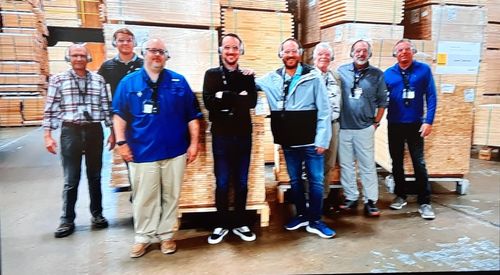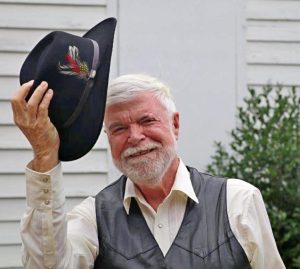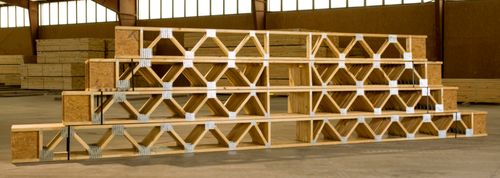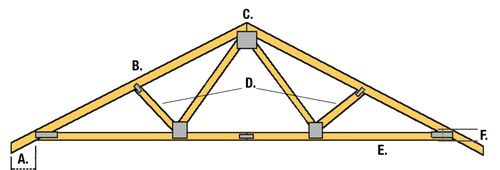24 Jul July 2023: Trusses – What’s the Point?

Number 113, July 2023
We are now on Instagram.
https://www.instagram.com/willissinclairhomes
Check out our projects!
The Marvin Window factory tour

Five builders from the Beaufort area and a couple of salesmen visited the Marvin Window factory in northern Minnesota this past month. We were wearing earphones so we could talk as we toured the factory. That is me third from the right.
At Marvin they like to say they build windows (and doors) for people, not for a warehouse. Each window is custom. To reduce the lead time, they pre-mill wood and stock it (behind us). When the order arrives, they trim the pre-milled wood to the nearest 1/64 of an inch and start the window construction.
Marvin ships about 1,000 windows (or doors) per day from the Warroad, Minnesota location.
From the Desk of Bill
We at Willis Sinclair hope you had a very happy and safe Independence Day as the United States celebrates her 247th Anniversary.
America is not without problems, but if it were not still great, people would not be coming here by the thousands.
This past month, I visited the Marvin Window factory in northern (as in 6 miles from the Canadian border) Minnesota. A group of five builders (including me) and two salesmen from Grayco made the trip.
The factory is large, some 2,200,000 square feet under roof and employees about 2,000 people. Considering the size of the town where it is located is 1,820 people, according to the sign entering town, that is amazing. There are several other small communities that house workers, obviously.
I have visited and worked in a number of factories (electronic and automotive) and was impressed with the Marvin Factory. It was clean and very well lighted. The employees seemed to really know their jobs and seemed happy. Marvin has a good bit of automation, but also a lot of “hands on” work.
The Marvins also seem to treat their employees well. They have a medical clinic inside the factory for employees and their families. One of the Marvin families is building a fine arts center for the community. Marvin also has a large home center like a Lowe’s in town.
We toured a small museum they have that traces the history of the Marvin company. Our guide, told a story about the first Marvin. He had the hardware store in town. Marvin’s desk faced the checkout counter and he either had a cased opening between his office and the counter or always kept the door open. On his desk, he kept root beer flavored hard candy: he liked it and it was a “child magnet.”
When families would visit the hardware store, he welcomed the children to stop by his desk and have some candy. The children would chatter and he would listen, but not question. He knew what was going on in town. He knew who was low on firewood. He knew whose pantry was getting empty. He knew who needed a doctor. When he found out someone needed something, but would not say anything, he would have firewood or flour or whatever delivered to them.
That fits nicely with the Royal Law (James 2:8)
Love your neighbor as yourself.
On a different subject, I read an article this past month that got me to thinking about a question that was posed. The question went something like this:
Suppose you wanted to purchase a major league ball team. You had a choice of two teams.
Team 1 was put together using the DIE (sometimes called DEI): Diversity, Inclusion and Equity criteria. It had members of all average ability – equity, you know. No superstars here because they would make the others feel bad. All players are paid the same in the name of equity. Most of the major races and (real and perceived) genders were on the team. Major political persuasions were present: communism, socialism and perhaps even a capitalist – maybe. All world religions – except Christian, of course – were included. There were no age restrictions used when assembling this team. Children and old folks are welcome. No knowledge of the game is needed. No special abilities mattered.
Team 2 was assembled based on a MAH: Motivation, Ability and Hustle, criteria. Race does not matter. Gender does not matter. Age does not matter. Religion does not matter. Ability matters. Hustle matters. Motivation matters. The more super the superstars, the better – they will challenge others to work harder.
Now, for a trivial question: Which team would you choose – assuming winning was your objective?
A few more questions…
If you wanted to build a strong military, which criteria would you use?
Which criteria: DIE or MAH would help build a strong company?
Which criteria would build a strong, vibrant nation?
If you wanted to bring a country to its knees, which criteria would you push?
Would you ever use the DIE criteria?

Most of you know Abbey. She is one of our full time employees and part owner the business.
Abbey is a licensed Residential Builder here in South Carolina.
She manages a number of remodels and other tasks such as billing and making sure jobs move smoothly.
Abbey is our third youngest daughter. She is our only “western” girl. She was born when I was working in northern Arizona.
Trusses — What’s the Point?
Like many materials, wood is much stronger in compression (trying to make it shorter) and tension (trying to stretch it) than it is flexing. What if you could take advantage of the superior strength wood (and most materials) have under tension and compression? If you did that, you could use smaller lumber and still have strength.
|
Perhaps you have walked on a floor that seems “bouncy.” That is likely because the joists were sized too small for the span. One solution would have been to upsize the dimension of the joists. A better solution might be to use a truss.
As you might be aware, triangles are inherently the strongest geometric figure. Squares will collapse if there is shear force on them. Triangles won’t.
A truss is simply a combination of triangles with the sides fastened at the end.

These are Trimjoists. They are floor trusses that can be trimmed to length (within reason). Notice the triangles. The ends have a piece of solid OSB that can be trimmed to length depending on the desired span. The center opening does not need to be a triangle for strength.
In a floor application, the flooring would be attached to the top chord (board) of the truss. The chord spans very short distances compared to the total length of the truss, so flexing is greatly reduced. The triangles keep the joist from sagging, so the floor is solid.
Floor joists also provide a way to run mechanical items (wires, pipes, ducts) under the floor without cutting large holes in the joists. The center rectangular opening is ideal for HVAC ducting.
Since floor joists are made of triangles, they can span large openings — something dimensional lumber cannot do.
Roof trusses also are made of triangles. With a triangle all forces on the sides of the triangle are either compression or tension. Only the top chord has a flexing load on it and the spans are short, so that is not a problem.

Roof trusses are made with triangles as you would expect. The bottom chord is under tension. The two top chords (the sides of the triangle) are under compression. Notice the span on the rafter is now half what it would be if a truss were not used. There are many, many different styles for roof trusses. The gray squares are structural plates to connect the truss elements together. When calculating loading, the connecting plates would be assumed to be a simple pin where no rotational load would be applied.
By loading lumber axially (tension or compression), the elements of the truss can be downsized to save material and weight, yet retaining strength.
If you have any questions about trusses, call or text (843 846 2500), email (info@willissinclair.com), stop by one of our job offices or flag us down if you see us. We can help. No cost or obligation to you, of course.








No Comments